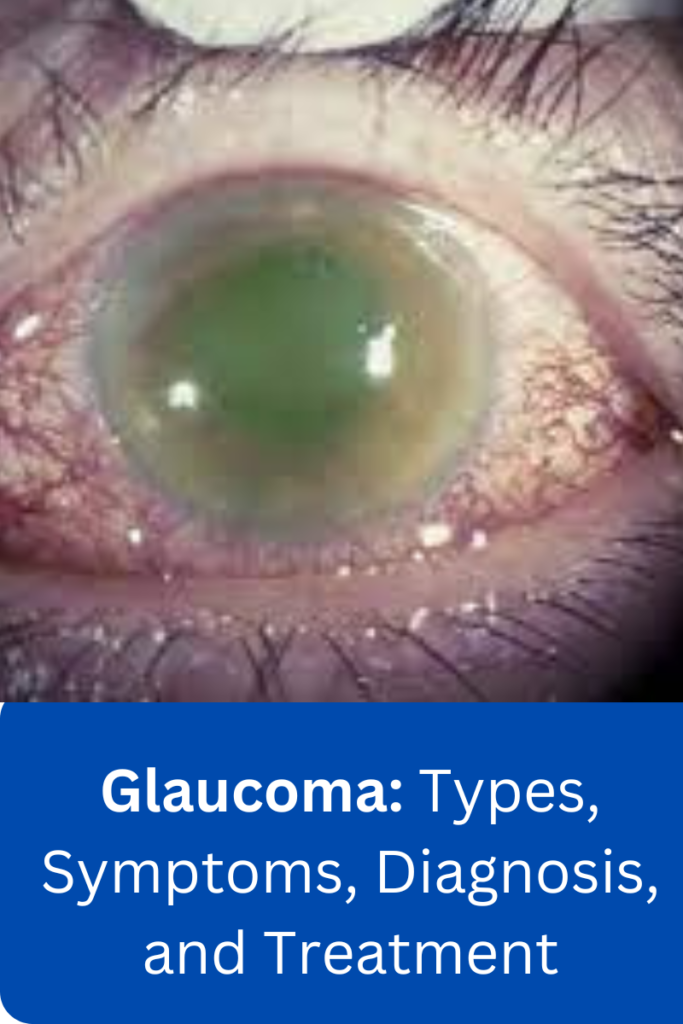Glaucoma can lead to irreversible blindness if left untreated. It is typically more common among older adults, although it can manifest at any age. Detecting glaucoma early through proper diagnosis can lead to better and more effective treatment.

Early screening for glaucoma is important as it often presents no warning signs. Optical Coherence Tomography (OCT) is the most effective method for early detection and safeguarding your precious eyesight.
If you’re concerned about your risk of developing glaucoma, it’s best to continue reading to learn more about the symptoms and diagnosis.
What is Glaucoma?
Glaucoma is a persistent eye disorder of the optic nerve caused by an abnormality in the eye’s drainage system, which can increase pressure and lead to permanent blindness or vision loss if left untreated.
Furthermore, this pressure in the eye is known as intraocular pressure (IOP) which occurs when there is an imbalance in the amount of fluid entering and exiting the eye.
Types of Glaucoma
There are several types of glaucoma, including:
1. Open-angle
This is the most common glaucoma and it is caused by an open angle of the anterior chamber resulting in changes in the optic nerve head, peripheral vision loss, and central visual field loss. It is chronic, progressive, and irreversible.
2. Closed-angle
This demands immediate attention as it causes a sudden increase in eye pressure due to fluid blockage. Act fast if you notice any symptoms of closed-angle glaucoma – your eyesight is priceless.
3. Low-tension
This is also known as normal tension glaucoma (NTG). It damages retinal cells and can cause bilateral blindness. Unfortunately, it can be hereditary, and other risk factors include age, irregular blood flow to the optic nerve, diabetes, sleep apnea, Raynaud’s syndrome, migraines, and anatomical abnormalities. Early detection and management are important.
4. Pigmentary
This arises when pigment disperses from the iris into adjacent structures, leading to secondary open-angle glaucoma.
5. Congenital
Some babies are born with or develop enlarged eyes within the first month of life. This condition is also known as newborn glaucoma. Usually, the increased pressure in the eyes occurs during fetal development.
It’s important to get an accurate diagnosis from a reputable diagnostic center to determine which type of glaucoma you have and receive appropriate treatment.
What is the normal eye pressure for Glaucoma?
The normal range of intraocular pressure is between 10-21 mm Hg, however, it may drop to 0 mm Hg in hypotony and go up to 70 mm Hg in some cases of glaucoma.
The pace at which optic nerve damage arises due to elevated intraocular pressure is determined by several factors, with the pressure level and the degree of glaucomatous damage being the most critical.
Who is more likely to get Glaucoma?
Although Glaucoma can affect anyone regardless of age, certain individuals are at higher risk of developing this serious eye disease. Below are the individuals more likely to get glaucoma if not detected early:
- Those over 40 years
- People with a family history of the disease.
- People with high fluid pressure inside the eyes are at an increased risk.
- Those with diabetes or other underlying health issues.
- People with high blood pressure.
- Those with severe myopia and individuals with a history of previous eye injury or surgery.
It’s essential to be aware of the risk factors and take preventative measures to protect your vision.
Also, have a conversation with your doctor about your risk for glaucoma and demand to know how often you need to undergo check-ups. Furthermore, a comprehensive dilated eye exam every one to two years using Optical Coherence Tomography (OCT) is important.
Take charge and ensure you take the necessary steps to protect your vision.
What are the symptoms of glaucoma?
It is important to be aware of the symptoms of glaucoma and to seek medical help immediately if you experience any of them.
Some signs to look out for include seeing halos around lights, loss of vision, redness in the eyes, hazy vision (especially in infants), nausea, vomiting, eye pain, and severe headaches. These indications may suggest that you have glaucoma and require prompt medical attention.
Do yourself a great favor by taking preventative measures to protect your eyesight and scheduling regular eye exams with your healthcare provider.
Diagnosis
An abnormal or high eye pressure doesn’t automatically translate to glaucoma. While recognizing the signs and symptoms of glaucoma is important, it is important to understand the need to undergo a comprehensive dilated eye exam using an Optical Coherence Tomography (OCT).
Sometimes, people with normal pressure can have glaucoma, while some with high eye pressure may not.
An OCT provides a detailed view of the optic nerve and measures the thickness of the retinal nerve fibers. Early detection can initiate treatment before it causes irreversible vision loss.
Furthermore, it is recommended that individuals at higher risk, such as those over 40 or with a family history of the disease, get regular eye exams to ensure early detection and treatment.
Treatment
The most common way to treat glaucoma is by lowering the pressure in your eyes. Various treatment options are available, including prescription eye drops, oral medications, laser therapy, surgery, or a combination of these approaches.
Conclusion
Glaucoma is a serious eye disease that can lead to irreversible vision loss. It’s caused by an abnormality in the eye’s drainage system, which can increase pressure and damage the optic nerve. As the optic nerve gradually deteriorates, blind spots develop in your vision.
The damage starts at the edges of the visual field and slowly impacts the central vision, which can severely impact your daily life. Unfortunately, it can take months to years after the nerve damage has occurred before you begin to notice symptoms. It is essential to have regular eye exams. Neglecting this crucial aspect of healthcare can have serious consequences.
By taking preventative measures and catching the disease early, you can protect your vision and maintain your quality of life. Don’t wait until it’s too late – schedule your eye exam today.
Frequently Asked Questions About Glaucoma
Open-angle glaucoma is the most prevalent form of glaucoma, caused by an open angle of the anterior chamber of the eye, leading to changes in the optic nerve head, peripheral vision loss, and central visual field loss. It is a chronic, progressive, and irreversible condition that demands immediate attention.
Yes, it is hereditary, but by having regular eye check-ups, you can take steps to preserve your eyesight and prevent any potential problems from worsening.
Family history of glaucoma? You may also be at a higher risk of developing the condition. Therefore, it is highly recommended that you urge your loved ones to regularly visit an eye doctor for eye pressure and optic nerve checks. Early detection is key.
To achieve a normal eye pressure, you can make some simple yet impactful lifestyle changes.These lifestyle changes include: regular exercise, limiting caffeine and fluid intake, eating a healthy diet, elevating your head while sleeping, and following your doctor’s prescription.
